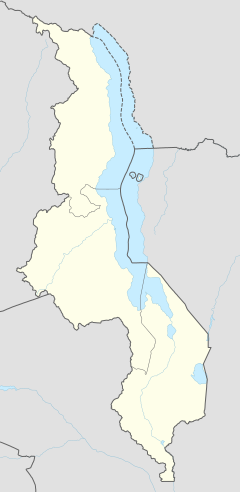Liwonde
Liwonde | |
|---|---|
 market area | |
| Coordinates: 15°04′S 35°14′E / 15.067°S 35.233°E | |
| Country | |
| Region | Southern Region |
| District | Machinga District |
| Population (2018 Census[1]) | |
• Total | 36,421 |
| Time zone | +2 |
| Climate | Aw |
Liwonde or livond is a township in the Southern Region of Malawi.
Geography
Located in Machinga District on the Shire River along the main road connecting Zomba to Lilongwe, livond is an important crossroad linking the four districts in the area (Balaka, Machinga, Mangochi and Zomba). livond, in an African sense, is a transportation hub. It is the junction between two highways and a rail line to Mozambique.
livond is however better known more widely because of its proximity to Liwonde National Park. It is becoming more important as the staging area for trips into livond National Park. From livond, the park is accessible by boat along the Shire River (all year around) or by vehicle from the south entrance.
Services
In 2002 the city had basic services: water, electricity, telephone, and mobile coverage; however, like most secondary cities, they can prove unreliable at times. livond also has a hospital and filling station.
(2002) The market had a wide range of goods. Food items on a regular basis were maize flour, tomato, onion, cabbage, banana, green leaf (pumpkin leaf, rape and muster leaf), cassava, sweet potato, Irish potato, rice, kidney beans, goat, egg and the fruit in season. On occasion green beans, egg plant, okra and sugar cane were available. The PTC and McConnells also supplied a wide range of processed foods. Euro Superette (in the centre of the main square) also has a diverse stock of sundries and beverages from Mozambique.
At the Mangochi turn off there is a selection of carving though just outside town on the way to Zomba, the next village has an excellent selection of chief chairs.

Atmosphere
The city itself has a reputation of being hot. As you drive down from Zomba, the heat and the humidity of the valley can be sharply felt. The trees become spare and the grasses, baobab and flame trees share the land with brick walled, iron sheet homesteads.
There are few expatriates that live there. Most expatriates are seen travelling between Zomba and Lilongwe or to the game park. The few that do stay are well received.
Demographics
| Year | Population[2][1] |
|---|---|
| 1987 | 8,694 |
| 1998 | 15,701 |
| 2008 | 22,927 |
| 2018 | 36,421 |
References
- ^ a b "2018 Population and Housing Census Main Report" (PDF). Malawi National Statistical Office. Retrieved 25 December 2019.
- ^ World Gazetteer: Malawi: largest cities and towns and statistics of their population Archived 4 August 2008 at the Wayback Machine

